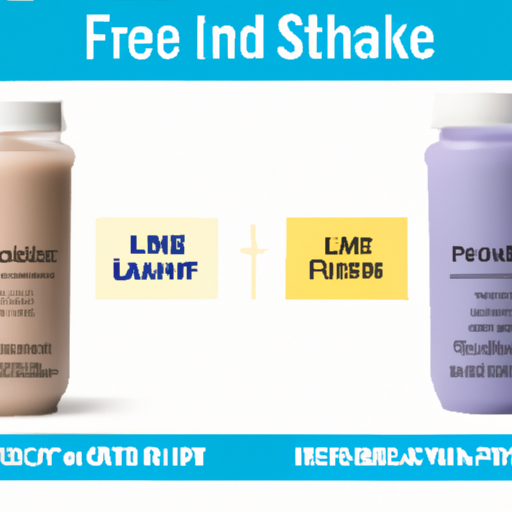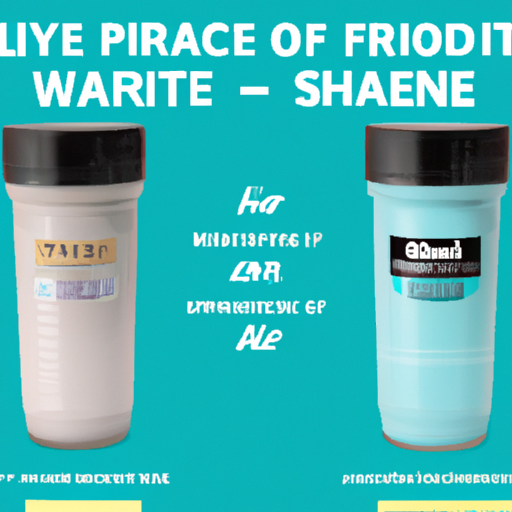Are you trying to decide between Fairlife Protein Shake and Whey Protein? Look no further! In this article, we will compare the two popular protein options, highlighting their similarities and differences. Whether you’re a fitness enthusiast looking to build muscle or someone seeking a convenient and nutritious snack, we’ll provide you with the information you need to make an informed choice. So, let’s dive right in and explore the benefits of Fairlife Protein Shake versus Whey Protein!

Nutrition Facts
When it comes to comparing nutrition facts, it’s important to take into account the specific needs and goals of each individual. Both fairlife protein shakes and whey protein offer various nutritional benefits that can support different lifestyles.
Calories
Fairlife protein shakes tend to have slightly fewer calories than whey protein powder. This can be advantageous for those who are looking to manage their calorie intake. However, it’s important to note that the overall caloric content will also depend on the serving size and any additional ingredients or additives.
Protein Content
Protein is an essential macronutrient that plays a crucial role in numerous bodily functions, including muscle synthesis and repair. Both fairlife protein shakes and whey protein are excellent sources of protein. However, whey protein powder generally has a higher protein content compared to fairlife protein shakes. This can be beneficial for individuals who are looking to increase their protein intake for muscle building or recovery purposes.
Carbohydrate Content
For individuals who are following a low-carbohydrate diet or have specific dietary restrictions, the carbohydrate content of a protein shake is an important consideration. Fairlife protein shakes generally have lower carbohydrate content compared to whey protein powder. This can be advantageous for those who are following a low-carb or ketogenic diet.
Fat Content
The fat content of protein shakes can vary depending on the ingredients and manufacturing process. Fairlife protein shakes are known for having a lower fat content compared to whey protein powder. This can be beneficial for individuals who are watching their fat intake or trying to achieve a leaner physique.
Vitamin and Mineral Content
Both fairlife protein shakes and whey protein can provide essential vitamins and minerals that support overall health and well-being. However, it’s important to note that the specific nutrient profile may vary depending on the brand, flavor, and formulation. Some protein powders may be fortified with additional vitamins and minerals, offering a potential advantage in terms of nutrient density.
Ingredients
Understanding the ingredients used in protein shakes is crucial for making an informed choice about which product aligns with your personal preferences and dietary restrictions.
Protein Sources
Whey protein, the main ingredient in most whey protein powders, is derived from milk. The extraction process results in a powdered form of protein that is high in essential amino acids. Fairlife protein shakes, on the other hand, utilize ultra-filtered milk as their primary protein source. This proprietary filtration process helps remove lactose while retaining a high protein content.
Additional Ingredients
Protein shakes can contain a variety of additional ingredients, such as sweeteners, thickeners, and preservatives. Fairlife protein shakes are known for their minimal ingredient lists, often comprising milk, natural flavors, and a few additional components. On the other hand, whey protein powders may contain added ingredients to improve taste, texture, or mixability. It’s important to carefully review the ingredient list to ensure it aligns with your dietary preferences and goals.
Artificial Sweeteners or Flavors
While some individuals may prefer protein shakes with natural sweeteners and flavors, others may find that products containing artificial additives suit their palate. Fairlife protein shakes are sweetened with a blend of sugar and stevia leaf extract, providing a balanced taste without an overwhelming sugary sensation. In contrast, the taste and sweetness of whey protein powders can vary depending on the brand and flavor. Some powders utilize artificial sweeteners to provide a more intense flavor profile without adding excessive calories.
Taste and Texture
The taste and texture of a protein shake can greatly impact your overall satisfaction and enjoyment. Finding a protein shake that suits your personal taste preference is key to making it a sustainable part of your routine.
Flavor Options
Fairlife protein shakes offer a range of flavors, including chocolate, vanilla, and strawberry. These flavors are generally well-received and provide a smooth and creamy taste. Whey protein powders, on the other hand, offer a wider range of flavors to choose from, including unique options like cookies and cream or salted caramel. This variety allows individuals to find a flavor that best suits their preferences.
Consistency
Protein shakes can range in consistency, from thin and watery to thick and creamy. Fairlife protein shakes are known for their smooth and creamy texture, making them enjoyable to drink. Whey protein powders, when mixed properly, can also offer a pleasant consistency. However, the final texture may vary depending on the brand, the amount of liquid used, and the mixing method.
Digestibility
An easily digestible protein shake can be beneficial for individuals with sensitive stomachs or those who experience digestive issues after consuming certain foods or beverages. Considering the digestibility of a protein shake can help you make an informed choice that aligns with your digestive health.
Ease of Digestion
Both fairlife protein shakes and whey protein powders are generally well-tolerated and easily digested by most individuals. The ultra-filtration process used in fairlife protein shakes helps remove lactose, making them a suitable option for individuals with lactose intolerance. Whey protein powder, although derived from milk, is often well-digested by the majority of people. However, some individuals may experience mild digestive discomfort or bloating due to the lactose or processing methods used in certain protein powders.
Gut Sensitivity
Individuals with sensitive stomachs or specific digestive concerns may need to pay extra attention to the ingredients and manufacturing processes used in protein shakes. Fairlife protein shakes are known for their gentle impact on the digestive system, making them a favorable choice for those who are prone to gut sensitivity. However, it’s important to consider personal tolerances and potential allergies to specific ingredients when choosing a protein shake.

Cost
The cost of protein shakes can vary significantly depending on the brand, product type, and serving size. Understanding the price comparison and evaluating the value for money can assist in making an informed decision.
Price Comparison
When comparing the price of fairlife protein shakes to whey protein powder, it’s essential to consider the serving size and the number of servings per container. Fairlife protein shakes, usually sold in ready-to-drink bottles, tend to be more expensive per serving compared to whey protein powder purchased in bulk. However, the convenience of a pre-mixed shake may be worth the additional cost for some individuals.
Value for Money
The value for money of a protein shake depends on various factors, such as the nutritional content, quality of ingredients, and overall satisfaction. While fairlife protein shakes may be more expensive per serving, their high protein content and minimal ingredient list offer value in terms of nutritional quality. On the other hand, whey protein powders purchased in bulk may provide a more cost-effective option for individuals who prioritize price while still meeting their protein needs.
Convenience
The convenience of a protein shake can greatly impact its usability in your daily routine. Considering factors such as the ready-to-drink versus powdered options and the portability of the product can help determine which option best suits your lifestyle.
Ready-to-Drink vs. Powdered
Fairlife protein shakes are ready-to-drink, which means they are pre-mixed and packaged in individual bottles. This convenience makes them an easy grab-and-go option for individuals with busy schedules or those who prefer minimal preparation. Whey protein powder, on the other hand, requires mixing with liquid before consumption. This additional step may not be as convenient for those on the move or lacking access to a suitable mixing method.
Portability
Portability is an important factor to consider, especially for individuals who travel frequently or require protein supplementation while on the go. Fairlife protein shakes are highly portable, making them suitable for packing in a gym bag, purse, or lunchbox. Whey protein powders, although not as convenient to transport in their powdered form, can be transferred into portable containers or single-serving packets for easy access while traveling or during outdoor activities.

Allergen Concerns
For individuals with specific allergen concerns or dietary restrictions, understanding potential allergens present in protein shakes is crucial for making a safe and suitable choice.
Lactose Intolerance
Individuals with lactose intolerance may experience digestive discomfort, bloating, or other symptoms when consuming lactose-containing products. Fairlife protein shakes utilize ultra-filtration to remove much of the lactose naturally present in milk, making them a viable option for individuals with lactose intolerance. Whey protein powder, although derived from milk, typically contains a small amount of lactose. However, there are lactose-free whey protein powders available that have undergone additional processing to remove the lactose.
Sensitivity to Artificial Ingredients
Some individuals may be sensitive to artificial ingredients, such as sweeteners or flavors. Fairlife protein shakes are sweetened with a blend of sugar and stevia leaf extract, providing a more natural option for those who prefer to avoid artificial additives. Whey protein powders, depending on the brand and flavor, may contain artificial sweeteners or flavors to enhance taste without adding excessive calories. It’s important to review the ingredient list to determine if any artificial additives are present that may cause sensitivity or adverse reactions.
Sustainability
Considering the sustainability of protein shakes can help individuals make an environmentally conscious choice that aligns with their personal values.
Sourcing of Ingredients
Fairlife protein shakes are made from ultra-filtered milk, which uses fewer resources compared to traditional milk production. This process also results in a higher ratio of protein to milk volume, contributing to a more sustainable product. Whey protein powder is derived from milk as well, but the environmental impact may vary depending on the sourcing and manufacturing practices of the brand.
Packaging
The packaging of protein shakes can significantly contribute to waste generation. Fairlife protein shakes are typically packaged in recyclable materials, such as plastic bottles. Considering the recycling capabilities in your area and choosing a protein shake that utilizes eco-friendly packaging can help reduce your ecological footprint. Whey protein powders, when purchased in bulk, can help minimize packaging waste compared to individually packaged options.

Effectiveness
The effectiveness of a protein shake can be measured based on its ability to support specific health and fitness goals, such as muscle building or weight management.
Muscle Building
Protein is essential for muscle growth and repair. Both fairlife protein shakes and whey protein powders provide a high-quality source of protein that supports muscle building when consumed as part of a balanced diet and exercise routine. The higher protein content of whey protein powder may offer a slight advantage for individuals looking to optimize muscle protein synthesis.
Weight Management
Protein shakes can be a valuable tool for weight management, as protein promotes satiety and can help decrease overall caloric intake. Both fairlife protein shakes and whey protein powders can aid in weight management when incorporated into a well-balanced diet and lifestyle. The lower calorie content of fairlife protein shakes may be beneficial for individuals aiming to achieve calorie deficits for weight loss goals.
Special Features
Consider any additional nutrients or benefits offered by a protein shake, as well as certifications or claims that may influence your decision.
Added Nutrients or Benefits
Some protein shakes are fortified with additional nutrients or ingredients to provide specific benefits. Fairlife protein shakes, for example, are enriched with DHA omega-3 fatty acids, which support brain and heart health. Whey protein powders may also offer additional benefits, such as added fiber or probiotics, depending on the specific formulation and brand.
Certifications or Claims
Some protein shakes carry certifications or claims that indicate their quality or adherence to specific standards. Fairlife protein shakes are lactose-free and often marketed as offering a higher protein content compared to traditional milk. Whey protein powders may be certified by third-party organizations, such as NSF International, to ensure they meet strict quality and safety standards. Checking for certifications or claims can provide confidence in the product’s reliability and adherence to specific dietary preferences or requirements.
In conclusion, both fairlife protein shakes and whey protein powders offer various considerations and benefits. When choosing between the two, it’s essential to assess your individual goals, dietary preferences, and lifestyle factors. Considering factors such as nutrition facts, ingredients, taste and texture, digestibility, cost, convenience, allergen concerns, sustainability, effectiveness, and any special features or certifications can help guide your decision and ensure you find a protein shake that best suits your needs. Remember to consult with a healthcare professional or registered dietitian if you have any specific dietary concerns or questions. Happy protein shake exploring!
